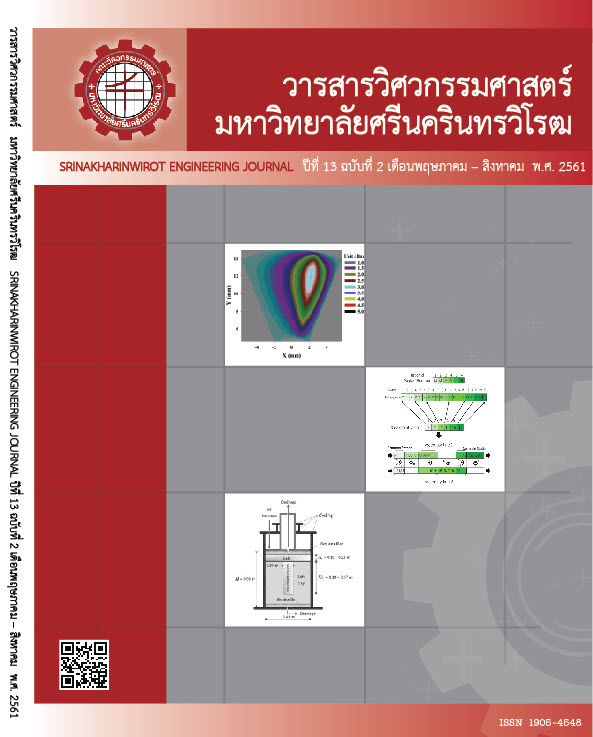Balancing Coffee Kit Assembly Line: a Case Study of a Sample Factory
Main Article Content
Abstract
This research aims to increase productivity of the coffee kit assembly process of a case study. The procedure are as following: production recording, analyzing and improving, new jobs balancing and new working methods designing by using techniques of ECRS (Eliminate, Combine, Rearrange, Simplify), line balancing techniques and motion study. They were used in real production and performance was measured for process improvements. The results obtained from the recording and analysis of data were found that there were 13 stations of coffee kit making process, straight line, and each step took very different time. This has resulted in some waiting stations and loss of production. There were 24 workers in manual coffee assembly line which was unsuitable. A processing time (takt time) took 1.266 second. The assembly line performance is 74.97 percent. To reduce a cycle time in workstation, an assembly line was balanced in order to meet the required production rate. The results showed that one workstation and 2 workers could be eliminated. Labor savings were 8.3 percent and takt time was reduced to 1.20 second. Productivity was increased by 5.2 percent. Moreover, the assembly line performance was increased to 84.93 percent.
Article Details
Copyright belongs to Srinakharinwirot University Engineering Journal
References
[2] Ratanawilaiwan. (1976). Line Balancing in a small Diesel Engine Assembly Plant with Consideration on the Local Content Government Regulations. AIT. Thesis, AIT, Bangkok Thailand.
[3] Phiphop Lalhitaporn. (2002). Planning System and Production Control. Edition 8th. Bangkok:Technology Promotion Association (Thailand-Japan).
[4] Jukarin krunkarn. (2015). Heuristic Method for Assembly Line Balancing a Case Study in Refrigerator Factory. Journal of Kasem Bundit University, 5(2), : p. 56-68.
[5] Chumpol Saroungkarasiri. (2007). Production and Planning Control. Edition 15th. Bangkok: Technology Promotion Association (Thailand-Japan).
[6] Arcus, A.L.(2012). COMSOAL: a computer method of sequencing operations for assembly lines. International Journal of Production Research, 4: p. 277-259.
[7] Heap, J. (2007). Stormy productivity weather ahead. International Journal of Productivity and Performance Measurement, 56(2): 170-177.
[8] Biswas S, Chakraborty A, Bhowmik N. (2016). Improving Productivity Using Work Study Technique. International Journal of Research in Engineering and Applied Sciences, 6: p.49-55.
[9] Hamid TKA. (1996). The slippery path to productivity improvement. IEEE Software, 13: p.43-52.
[10] Raut RS, Deshmukh HM. (2014). Productivity improvement of a prestress concrete pole plant using work study technique. International Journal of advanced Technology in Engineering and Science, 2: p.496-508.
[11] Ozor PA, Olua CLOCK. (2015). Productivity Improvementof Small and Medium Scale Enterprises using Lean Conceptâ:Case Study of a Bread actory. European Journal of Business and Management, 7: p.73-84.
[12] Chandra PV. (2013). An Effort To Apply Work and Time Study Techniques in a Manufacturing Unit for Enhancing Productivity. International Journal of Innovative Research in Science, Engineering and Technology 2: p.4050-4058.
[13] Kulkarni PP, Kshire SS, Chandratre KV.(2014). Productivity Improvement Through Lean Deployment and Work Study Methods. International Journal of Research in Engineering and Technology, 3: p.429-434.
[14] Hassanali KN. (2011). A Productivity Model Utilising a Work Study Approach for Performance Measurement. The Journal of the Association of Professional Engineers of Trinidad and Tobago, 40: p.13-25.
[15] Kumar N, Mahto D. (2013). Productivity Improvement through Process Analysis for Optimizing Assembly Line in Packaging Industries.Global Journal of Researches in Engineering Industrial Engineering, 13: p.1-17.
[16] Khatun, Murshida M. (2014). Effect of Time and Motion Study on Productivity in Garment Sector. International Journal of Scientific & Engineering Research, 5:p.825-33.

